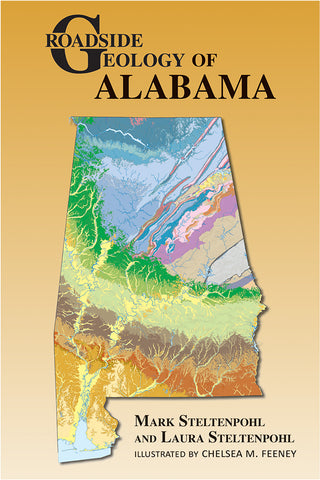Roadside Geology of Alabama
Mark Steltenpohl and Laura Steltenpohl
Illustrated by Chelsea M. Feeney
Several generations of Southerners claim the Lynyrd Skynyrd song, “Sweet Home Alabama,” as their anthem. The Billie Holiday hit “Stars Fell on Alabama” is another, and though an actual star didn’t fall on Alabama, the state is the only place on Earth where a person has been injured by a meteorite. Another impact, this one about 80 million years ago, left the 5-mile-wide Wetumpka impact crater in the center of the state. Alabama’s world-class geology, nearly as famous as its music, includes tracks of early amphibians and reptiles, fossilized bird feathers, and 2-billion-year-old mineral grains eroded from rocks now found in Africa. And lest you think Alabama is just alligator swamps and estuary mud, you can view Little River Canyon, in places 600 feet deep, atop Lookout Mountain, a broad plateau incised by waterfall-laced rivers at the southern end of the Appalachian Mountains.
The authors intertwine the geology with cultural stories, legends, and history to paint an enjoyable picture of how Alabama and its rocks came to be. For example, Tannehill Ironworks and iron mines in Red Mountain Park and Ruffner Mountain Nature Preserve document Birmingham’s industrial birth as the source of iron for the Confederacy. Buildings at Cheaha State Park in the Talladega Mountains were constructed by the Civilian Conservation Corps using blocks of locally quarried Cheaha Quartzite. Native Americans chiseled stone axes out of the Hillabee greenstone, one of Alabama’s ancient volcanic rocks. With this book as your guide, find caverns in fossil-rich limestone, shark teeth in the shifting sands of the Gulf Coast, and rocky outcrops in Muscle Shoals along the banks of the Tennessee River, known to Native Americans as the “singing river.”
360 pages, 6 x 9, paperback
ISBN 978-0-87842-714-7
Geological Society of America
-
Sale
- Regular price $28.00

